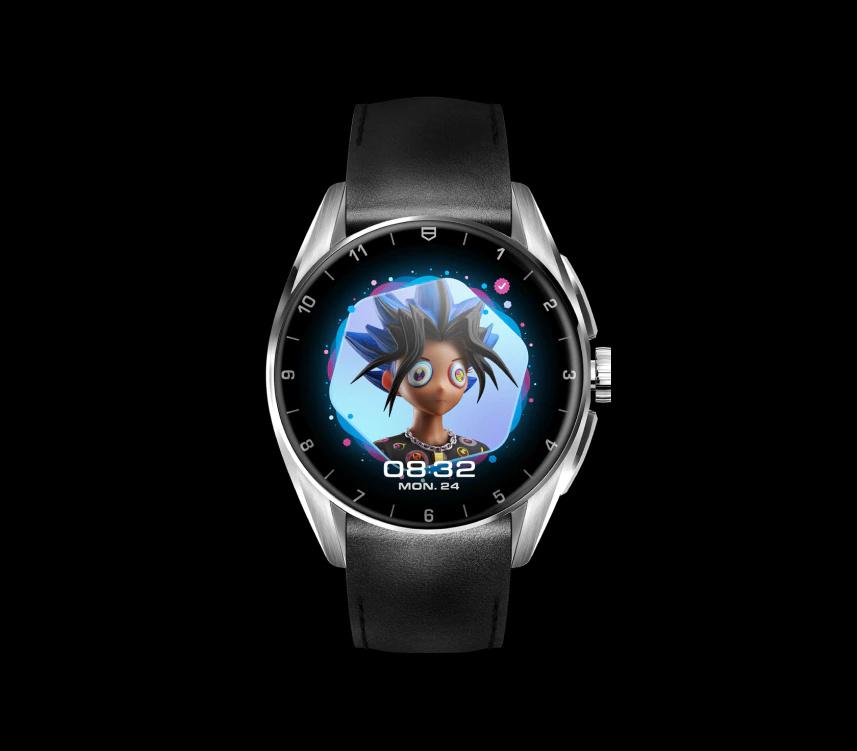TAG Heuer CONNECTED Calibre E4
Prince once said, “Time doesn’t exist. Clocks exist. Time is just an agreed-upon construct.” The same could and has been said about ownership of digital artworks and NFTs. Can you really own something that has been replicated thousands or sometimes millions of times online? You can, but only because we all agree that you can.
Recently, TAG Heuer made history by leveraging its storied craftsmanship to bring these two theoretical constructs together with a software update to its Connected Calibre E4 collection. The company announced the update in June, which allows owners of the watches to display their NFT artworks directly on their wrists.
MetaMask is a software cryptocurrency wallet.
TAG Heuer’s new software feature, called the Lens, allows you to connect crypto wallets such as Metamask and Ledger Live, then display one or several NFTs on your connected watch. Lens supports both static images and animated GIFs, which will play as endless loops. Verified NFTs are displayed in a hexagon with a cloud of particles gravitating around the image, allowing you to prove that the NFT displayed on your watch is authentic — as long as the person you’re trying to prove it to is familiar with this feature.
And, because it’s still a watch, Lens features “a new conceptual design” that allows wearers to tell the time “with a triangle and a circle representing hours and minutes.”
For those unfamiliar with the technology, NFTs (non-fungible tokens) are digital assets whose ownership is recorded on a decentralized digital ledger called the blockchain, the same technology that drives cryptocurrency. NFTs can be anything from a GIF of Michael Jordan dunking from the free-throw line to digital artwork.
For both creators and collectors of digital art, NFTs and blockchain technology have been monumental. Creators can now be compensated similarly to traditional artists. And because their authenticity can be verified, those digital artworks can increase in value, making them appealing to collectors
Now digital collectors can display their art directly on their timepieces.
Previous President & CEO of The Walt Disney Company Robert Iger with his 1930’s Mickey Mouse Watch … [+]
As much as this feature is the first of its kind, the idea of wearing pop art on your wrist isn’t new — Mickey Mouse has graced the faces of timepieces ranging from Timex to Rolex beginning in 1933. The Apple Watch features dozens of ways to customize the display, though it does not have native support for displaying verified NFTs.
Apple Watch, launched in 2015, was Apple’s first new gadget under Chief Executive Officer Tim Cook
TAG Heuer also isn’t the first luxury brand to embrace blockchain. Gucci, Louis Vuitton, and countless others have launched NFTs with mixed results. But, its embrace of blockchain technology as fundamental to its future puts TAG Heuer in the same category as other forward-thinking manufacturers – Fendi partnered with Ledger on a luxury hardware crypto wallet, Samsung launched an integrated NFT marketplace, and a growing number of luxury brands, including TAG Heuer and parent company LVMH, have started accepting cryptocurrency.
In some ways, this release is a logical progression for the 162-year-old heritage brand. Founded in 1860, Heuer has continually been at the forefront of its industry, inventing revolutionary technologies including the Mikrograph, the first stopwatch capable of accurately measuring increments of 1/100th of a second, the first automatic-winding chronograph movement, and the first luxury smartwatch. Astronaut John Glenn wore a Heuer wristwatch on his first orbit around the earth.
TAG Heuer Carrera detail
On the other hand, this is a departure. Most of the company’s innovations have centered around precision and performance, making them favored timepieces among pilots, divers, and other consumers for whom accuracy is of the utmost importance. Beyond signaling status for the device owner, there is no practical reason to display a looping GIF with proof of ownership on a wristwatch. Though, to be fair, many innovations in horology, including the invention of the wristwatch, were initially regarded as frivolous. The first wristwatches were treated as jewelry and owned almost exclusively by women.
Women’s Cartier Wristwatch
And, practicality isn’t really the point for the NFT crowd. While companies like Atomic Form and Infinite Objects are working to integrate NFTs into the traditional ways we experience art, others are embracing the way NFTs integrate art into our everyday lives.
Users with premium Twitter accounts can display verified NFTs as their profile pictures. People interact with NFT artworks in video games. Others display NFTs on their dormant computers and smart TVs as expensive screensavers, functioning as display art until someone clicks to wake up the device. That means we’re often experiencing breathtakingly expensive pieces of art in the same way we experienced the Flying Toasters screensaver in the early 90s.
“Flying Toaster” screensaver by Berkeley Systems, created in 1989
This subversive approach to art and currency is the founding ethos of the crypto community. Perhaps displaying an 8-bit punk avatar worth more than $170,000 — but only because the market agrees it is — on a watch made by one of the most well-respected heritage brands on the market matches that ethos perfectly.
Owners of the TAG Heuer Connected Calibre E4 can access the new feature via a free update in the Apple App Store (the update is coming to Android soon). Those interested can learn more about TAG Heuer’s NFT watch here:


